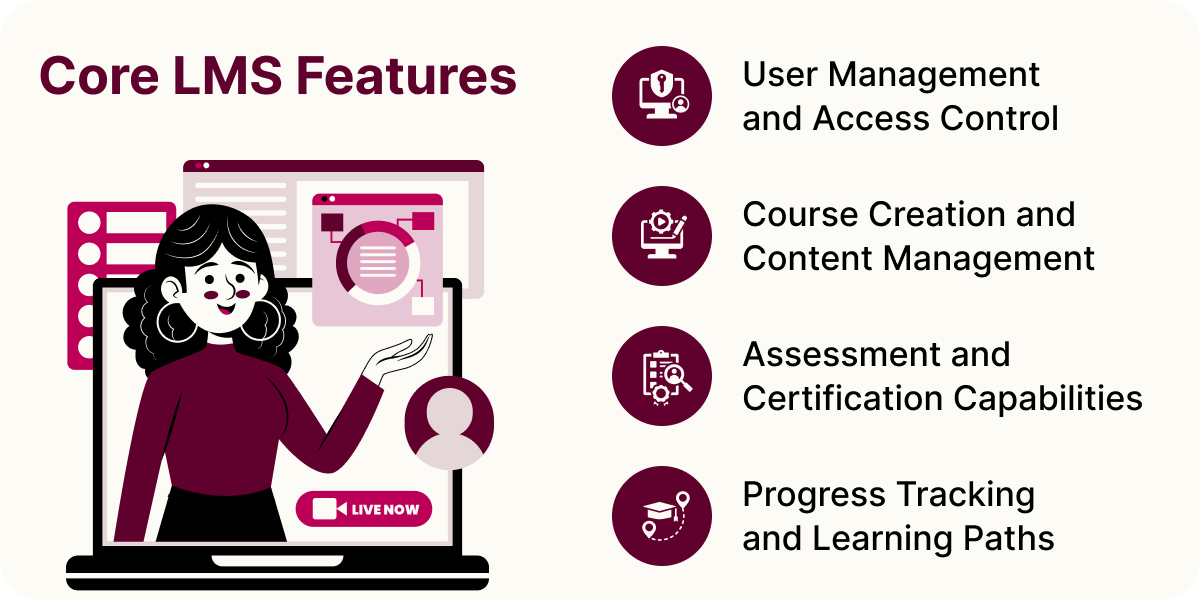Essential Learning Management System Features Every Organization Needs in 2025

Learning management system features that drive measurable business outcomes include robust reporting and analytics, mobile accessibility, AI-powered personalization, seamless integrations with existing systems, comprehensive compliance tracking, and engagement tools that boost completion rates.
Let's take a closer look at the article to explore everything in detail.
What Makes an LMS Essential in 2025
A learning management system is a software product that administers, documents, tracks, reports, and delivers educational courses or training programs.
LMS platforms emphasize structured, administrator-led training with strong compliance tracking. Learning Experience Platforms, a subtype of modern LMS software, prioritize learner-driven discovery and content curation.
These innovations reflect the rising demand for learning automation across industries on a global scale. Remote and hybrid work models require training that reaches employees regardless of location or device. The World Economic Forum estimates that 44% of workers' skills will be disrupted by 2027, making systematic learning infrastructure essential. Besides, regulatory complexity continues to increase across industries, making automated tracking and reporting non-negotiable.
That’s why it is not surprising that the global LMS market reached $13.38 billion in 2021 and is projected to grow at 19.1% annually through 2028, according to Grand View Research.
Core LMS Features Every Organization Must Have
Essential LMS features 2025 begin with fundamental capabilities that enable basic training administration while creating foundations for advanced functionality. Here are the main functions a demanded, functional LMS should possess.

User Management and Access Control
Effective user enrollment management allows administrators to organize learners by department, location, role, or custom attributes without manual data entry. Automatic HRIS database synchronization creates user accounts and assigns appropriate permissions based on employee data. Automation reduces administrative time by 67% compared to manual account creation.
Role-based permissions enable tiered access for administrators, instructors, managers, and learners while allowing granular control over who can create content, run reports, or access sensitive compliance data. Single sign-on integration eliminates the friction of separate login credentials, reducing adoption barriers by 23%.
Key user management capabilities include:
- Automated user provisioning. Account creation, role assignment, and course enrollment happen automatically based on HRIS employee data without IT intervention, reducing onboarding time from days to minutes.
- Hierarchical organization structures. Platforms must reflect complex reporting relationships, allowing managers to view direct reports while giving executives visibility across divisions without granting individual record modification rights.
- Custom user attributes. Beyond standard fields like department and location, an LMS can tag users by certifications held, languages spoken, shift schedules, or business-specific data. This categorization increases the accuracy of training requirements.
- Bulk user operations. Administrators upload CSV files to create hundreds of accounts simultaneously, update multiple user attributes at once, or reassign course enrollments during organizational restructuring.
Course Creation and Content Management
Robust course authoring tools enable subject matter experts to build training without technical expertise. Built-in editors should support diverse content types, including video, documents, presentations, and interactive elements. Multi-format content support accepts industry-standard packages like SCORM 1.2, SCORM 2004, xAPI (Tin Can), and AICC for content created in external authoring tools.
Content library management becomes critical as training catalogs grow. Version control ensures instructors can update courses while current learners continue with the original version until course completion. Content approval workflows route new courses through subject matter experts and compliance reviewers before publication.
Assessment and Certification Capabilities
Testing tools must support multiple question formats, including multiple choice, true/false, matching, essay, and scenario-based assessments. Randomized question pools prevent cheating by presenting different questions to each learner while maintaining equivalent difficulty. Question banks enable reuse across multiple courses.
Certification tracking automates credential management by issuing certificates upon course completion, tracking expiration dates, and triggering renewal notifications. For regulated industries, automated tracking eliminates manual spreadsheets and reduces audit preparation from weeks to hours.
Progress Tracking and Learning Paths
Learner progress monitoring provides real-time visibility into who has started, completed, or is overdue for required training. Managers review team completion rates using LMS dashboards without accessing individual learner data, balancing oversight with privacy.
Automated learning paths sequence courses based on prerequisites, role requirements, or competency frameworks, creating clear development roadmaps. Conditional logic allows completion of certain courses to unlock additional content, enabling progressive skill building.
Advanced Features That Drive Learning Effectiveness
Advanced LMS capabilities separate platforms that merely deliver content from those that actively improve learning outcomes and business performance.

AI and Personalization Technologies
Artificial intelligence in LMS platforms has matured from experimental to practical uses in 2025. It aids both educators and students in many ways, ranging from content personalization to LMS model training and refinement.
- Intelligent content recommendations analyze learner behavior, role requirements, skill assessments, and career goals to suggest relevant courses.
- Adaptive learning technology adjusts content difficulty and pacing based on individual performance. Learners who demonstrate mastery skip redundant material, while those struggling receive additional explanations and practice opportunities.
- Machine learning training platforms continuously improve recommendations as they gather more data about what content combinations produce the best outcomes.
AI-powered features transforming learning include:
- Automated content tagging. Platforms analyze course materials to extract topics, difficulty levels, and skill alignments without manual categorization, making content discoverable through natural language searches.
- Intelligent learning path generation. Assessment of each learner's current competencies and career goals automatically constructs personalized development plans that sequence courses for optimal skill progression.
- Predictive completion modeling. Algorithms identify learners at risk of abandoning courses based on engagement patterns, triggering interventions like manager notifications or additional support resources before dropout occurs.
- Natural language chatbots. AI assistants answer learner questions about course content, platform navigation, or certification requirements 24/7 without human support staff, resolving 73% of inquiries without escalation.
Gamification and Social Learning Tools
Gamification features tap into intrinsic motivation through points, badges and leaderboards, and achievement levels that make progress visible and rewarding. Points should reward learning behaviors like consistent daily practice or helping peers, not just completion speed.
Social learning capabilities enable employees to learn from each other through discussion forums, peer content sharing, and collaborative projects. Peer-to-peer learning proves especially valuable for tacit knowledge that resists formal documentation. Features like user-generated content, course ratings, and expert identification help surface internal knowledge that might otherwise remain siloed.
Mobile Learning and Offline Access
Mobile LMS features have shifted from a bonus capability to a baseline requirement, as 67% of modern learners access training primarily through smartphones or tablets. Device-agnostic platforms sync progress across devices, allowing learners to start courses on desktop and continue on mobile without losing their place. Yet, there is still a debate about the best practices in mobile-first LMS design. Practice shows that choosing responsive design vs native app depends on use cases. Responsive web interfaces work well for video-based courses and reading materials. Native mobile apps excel for field workers who need offline learning capabilities where connectivity is unreliable.
Integration and Interoperability Features
LMS integration capabilities determine whether learning platforms become part of the organization’s broader workflow and IT infrastructure or remain as isolated systems requiring duplicate data entry. Here is a list of core integrations required for seamless LMS interoperability.
Critical System Integrations for Seamless Workflows
A functional LMS should integrate smoothly with other core business tools. These critical system integrations reduce administrative overhead, enhance security, and ensure training data flows seamlessly across the organization. For instance, HRIS/HCM integration automatically creates learner accounts when employees are hired, updates permissions when they change roles, and archives accounts when they leave. This tech stack connectivity eliminates manual user management while ensuring training assignments always match the current responsibilities of staff.
Single sign-on extends integration to authentication, giving employees one-click access to training alongside other business applications. Video conferencing integration with platforms like Zoom, Microsoft Teams, or Webex enables virtual instructor-led training within the LMS environment. CRM connectivity proves valuable for organizations training customers or channel partners, syncing training completion data into customer records.
API Standards and Technical Requirements
No business IT infrastructure exists in a vacuum today, with large-scale, ever-expanding ecosystems developed for process harmonization. For this reason, LMSs should have user-friendly API connectivity to integrate seamlessly into the existing business architectures.
REST API access allows organizations to build custom integrations with internal systems or specialized industry tools. Comprehensive documentation, generous rate limits, and webhooks for real-time event notifications distinguish developer-friendly platforms from locked-down systems.
xAPI standards (also called Tin Can API) enable tracking learning activities that happen outside the LMS, from reading articles to attending conferences to hands-on practice. The choice between open API vs limited integration impacts long-term flexibility.
Compliance, Security, and Administrative Features
Along with supporting the entire continuum of an organization’s learning needs, an LMS can aid in compliance and security aspects. For example, compliance tracking LMS functionality protects organizations from regulatory penalties, while LMS security features safeguard sensitive employee and business data. Let’s take a closer look at how it works in practice.
Compliance Management and Regulatory Tracking
Automated compliance reporting should flag upcoming certification expirations, identify employees missing required training, and generate audit documentation without manual input. Tracking regulatory requirements specific to your industry — whether annual safety training for manufacturing, continuing education credits for healthcare professionals, or anti-money laundering training for financial services — becomes systematic.
Audit documentation needs immutable records showing not just course completion but also course content versions, completion dates, assessment scores, and time spent. Sophisticated platforms maintain complete certification management, including proof of instructor qualifications, training location records, and equipment validation for hands-on components.
Data Security and Privacy Protection
Employee training data belongs to the category of sensitive data and requires adequate protection in line with data privacy regulations of a relevant jurisdiction, such as privacy controls GDPR or the like. Data residency options matter for organizations subject to regulations requiring employee data storage within specific countries. To address these needs, technically superior LMSs employ the following security measures:
- Data encryption, both in transit using TLS 1.3 or higher and at rest, protects training records from interception or breach.
- SOC 2 compliance indicates vendors follow rigorous security protocols validated by independent auditors.
- Multi-factor authentication adds protection against compromised passwords.
Critical security features organizations should verify also include:
- Role-based data access. Viewing of sensitive information, such as individual assessment scores, should be restricted to appropriate personnel while allowing managers to see team aggregates for the sake of employee privacy protection.
- Audit trail completeness. User logs, including logins, course accesses, assessment attempts, and content modifications with timestamps and user identification, should be available for forensic investigation.
- Automatic session timeout. Training accessed from shared computers requires automatic logout after brief inactivity periods, preventing unauthorized access to signed-in accounts.
- IP address restrictions. Organizations handling highly sensitive content can limit platform access to corporate networks, preventing access over public WiFi or unsecured connections.
Administrative Tools for Efficient LMS Management
Effective LMS administration is key to its scaling without overloading staff. Modern LMSs offer many functions for streamlined management in alignment with broader organizational needs. For example, workflow automation reduces administrative burden through automated enrollment triggered by hire dates or role changes, scheduled reports delivered to stakeholders, and deadline reminders sent to learners. Bulk operations enable administrators to enroll hundreds of learners, assign multiple courses, or update user attributes in minutes rather than hours.
Customization and branding allow platforms to reflect the company’s identity through logos, color schemes, and custom domains. Multi-tenancy support serves organizations with distinct divisions or brands that need separate learning environments while maintaining centralized administration and reporting.
Conclusion
In 2025, an LMS is more than a training tool, it’s a growth driver. The right platform combines essentials like compliance tracking and content management with advanced features such as AI personalization, mobile access, and seamless integrations. With solutions like GEOR Learn, organizations can build scalable, data-driven learning ecosystems that keep their workforce skilled, compliant, and future-ready.
Frequently Asked Questions






